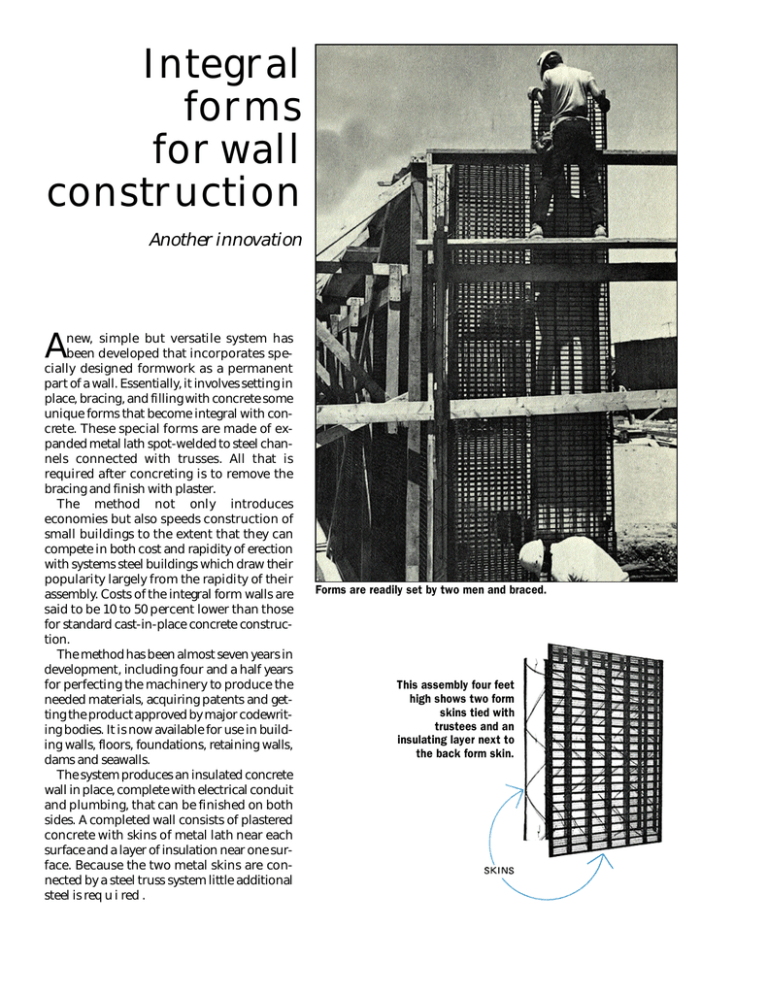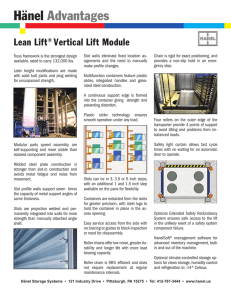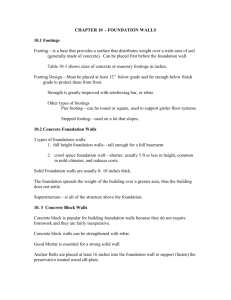
Integral
forms
for wall
construction
Another innovation
A
new, simple but versatile system has
been developed that incorporates specially designed formwork as a permanent
part of a wall. Essentially, it involves setting in
place, bracing, and filling with concrete some
unique forms that become integral with conc re t e. These special forms are made of expanded metal lath spot-welded to steel channels connected with trusses. All that is
required after concreting is to remove the
bracing and finish with plaster.
The method not only introduces
economies but also speeds construction of
small buildings to the extent that they can
compete in both cost and rapidity of erection
with systems steel buildings which draw their
popularity largely from the rapidity of their
assembly. Costs of the integral form walls are
said to be 10 to 50 percent lower than those
for standard cast-in-place concrete construction.
The method has been almost seven years in
development, including four and a half years
for perfecting the machinery to produce the
needed materials, acquiring patents and getting the product approved by major codewriting bodies. It is now available for use in building walls, floors, foundations, retaining walls,
dams and seawalls.
The system produces an insulated concrete
wall in place, complete with electrical conduit
and plumbing, that can be finished on both
sides. A completed wall consists of plastered
concrete with skins of metal lath near each
surface and a layer of insulation near one surface. Because the two metal skins are connected by a steel truss system little additional
steel is req u i red .
Forms are readily set by two men and braced.
This assembly four feet
high shows two form
skins tied with
trustees and an
insulating layer next to
the back form skin.
Construction sequence
The new method needs no conventional forms so it saves the labor
of stripping, cleaning and storing
forms for reuse. The forms are manufactured from expanded metal lath
and steel channels in 24-inch
widths and long enough for the wall
height desired. These are installed
by two men who can readily handle
forms long enough to make walls up
to 24 feet high. The form is attached
with a 10-inch clip at the bottom
and another at the top. Corners are
framed out and attached to bracing
that is set plumb. The forms are
available in thicknesses of four
inches through 12 inches (in oneinch increments) to provide the desired wall thickness. Window
f ra m e s, doors, electrical conduit,
plumbing and any required vertical
reinforcing steel are installed in the
form system prior to erection. After
the concrete has been cast the form
remains in place as part of the wall.
The prefabricated trusses installed between the form skins serve
first as form ties and later as reinforcing trusses in the concrete. Vertical form bracing is attached at
spacings of 10 feet or less, and diagonal bracing is attached at the top of
the wall and, on walls over 16 feet
high, at the middle as well.
For most work vertical deformed
bars are not needed because the
panels contain more steel than required by the ACI Building Code,
provided concrete of 3000 psi or
greater strength is used. If hori zo ntal bars are required, they must be
placed according to specifications
and the architectural drawings.
These are threaded through the
truss system and do not require ties
of any kind.
Walls of any height up to 30 feet
are cast in a single lift, using concrete of four- to six-inch slump
which is introduced at the top of the
wall by pumping. Some of the concrete extrudes through the expanded metal form skin, thereby bonding
to it and at the same time providing
a mortar layer on the exterior surface which can be finished by troweling. Disappearance of voids can
be monitored by watching them
through the expanded metal form
skin during placement. External viThe structure takes shape as forms are
set. Form assemblies are stored in piles.
A finished building.
Concreting is placed to
the full height of the wall
by pumping.
bration may be used to control the
amount of mortar coming through
the expanded metal form skin, and
to provide the quantity necessary
for the kind of finish intended.
The fresh surface is darbied and,
if desired, can be scratched to improve the base for the finish coat of
plaster. Almost any kind of finish
can be produced after the wall is
completed.
Finishing
For finishing, portland cement
plaster is used conforming to ASA
42.2 (four parts sand to one part
portland cement and 1/10 part lime
by volume). The mortar extruding
through the lath serves as the
scratch coat, so it is not necessary
to apply another. A brown coat is
applied to level the surface according to accepted plastering stand a rd s. The finish coat can be applied by hand or spray application
and given the desired texture. Control joints in the cast-in-place concrete wall and the wall plaster
should be detailed by the architect.
Interior surfaces can be finished
with either portland cement plaster
or gypsum plaster applied directly
without furring.
This small buttressed dam was built
with integral wall forms.
Materials.
The through-the-wall form system weighs a total of 2.11 pounds
per square foot of wall. This is made
of rib lath turned 90 degrees from
the usual direction of application so
that the ribs, located 1 5/8 inches on
centers, run horizontally. The channels, of 24-gage cold rolled steel, are
located four inches on centers running vertically and have been spot
welded to these ribs. The channels
form slots into which trusses fit.
Truss chords are made from 24gage cold rolled steel strips joined
with 10-gage (0.135-inch diameter)
bright basic commercial quality
wire.
The package of integral components can be supplied with or without polystyrene insulating sheets. A
oneinch-thick insulating sheet is
normally used in all building walls
but not in such structures as dams
and retaining walls. The insulating
sheet is cut to slide into the wall vertically and fit between the ve rt i c a l
steel channels.
Wall characteristics
The engineering data for bearing
Extruded mortar is darbied. This is later scratched and covered
wit two coats of portland cement plaster.
Sufficient mortar extrudes through form to provide the scratch coat
for portland cement plaster.
walls have been summarized in
Table I. The thermal conductivities
of walls containing a one-inch sheet
of polystyrene insulation are 0.20
Btu per inch per square foot per degree F per hour for walls of six- or
eight-inch thickness and 0.19 for
walls of 10- or 12-inch thickness.
Allowable compressive loads on
bearing walls made with concrete of
3000 psi strength are given in Table
II.
TABLE I Engineering data for bearing walls
4-inch thick 6-inch thick 8-inch thick 10-inch thick
wall
wall
wall
wall
Maximum allowable
height, feet
10
15
65
115
Maximum unsupported
width or height,
feet-inches
1 0-0
124
16-8
20-10
Distance between
suppor ting and
enclosing members of
panel walls, feet
10
15
20
25
Ver tical steel required,
square inches per
foot of wait length*
0.072
0.108
0.144
0.180
0 120
0 180
0.240
0.180
18
13
10
7
Horizontal steel
required, square inches
per foot of wait
height**
Optional horizontal
spacing of no. 4 Bars,
inches
*Vertical steel included in the three trusses and associated six channels in each foot of
width is 0.377 square inches.
**Area of expanded metal is 0.378 square inches per foot of height. (Not all local codes
allow credit for this steel in the horizontal direction, so additional horizontal steel may be required.)
TABLE II Compressive loads allowable on bearing walls, psi
(Concrete strength 3000 psi)
Wall height,
feet-inches
4-inch thick
wall
6-inch thick
wall
8-inch thick
wall
10-inch thick
wall
8
9
10
11
530
468
390
632
614
590
563
557
649
639
628
666
662
657
651
12
12-5
13
14
529
510
489
443
614
605
597
577
643
639
635
625
15
16
16-8
17
390
555
529
510
500
614
600
590
585
467
431
390
568
550
529
510
18
19
20
20-10
PUBLICATION #C730213
Copyright © 1973, The Aberdeen Group
All rights reserved
21
22
23
24
25
506
481
454
423
390




